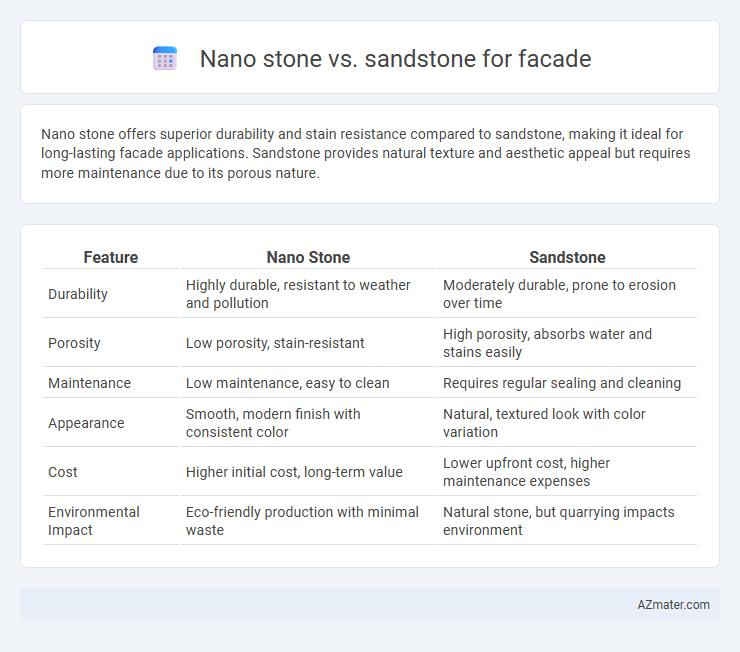Nano stone offers superior durability and stain resistance compared to sandstone, making it ideal for long-lasting facade applications. Sandstone provides natural texture and aesthetic appeal but requires more maintenance due to its porous nature.
Table of Comparison
| Feature | Nano Stone | Sandstone |
|---|---|---|
| Durability | Highly durable, resistant to weather and pollution | Moderately durable, prone to erosion over time |
| Porosity | Low porosity, stain-resistant | High porosity, absorbs water and stains easily |
| Maintenance | Low maintenance, easy to clean | Requires regular sealing and cleaning |
| Appearance | Smooth, modern finish with consistent color | Natural, textured look with color variation |
| Cost | Higher initial cost, long-term value | Lower upfront cost, higher maintenance expenses |
| Environmental Impact | Eco-friendly production with minimal waste | Natural stone, but quarrying impacts environment |
Introduction: Facade Material Trends
Nano stone and sandstone are prominent choices in modern facade material trends due to their durability and aesthetic appeal. Nano stone offers enhanced strength, resistance to weathering, and a sleek, contemporary finish through nanotechnology innovation. Sandstone provides a natural, textured look with excellent thermal insulation, favored for traditional and rustic architectural styles.
What is Nano Stone?
Nano stone is an advanced facade material composed of ultrafine silica particles bonded with resin, offering superior strength, durability, and water resistance compared to traditional sandstone. This innovative composite mimics the natural look of sandstone but provides enhanced protection against weathering, algae growth, and pollution, making it ideal for exterior applications. Nano stone's lightweight and low maintenance characteristics make it a preferred choice for modern building facades seeking both aesthetic appeal and long-term performance.
Understanding Sandstone Facades
Sandstone facades offer natural durability and a wide range of colors and textures, making them a popular choice for architectural exteriors. Their porous structure requires proper sealing to prevent moisture absorption and weathering, ensuring long-term resilience. Compared to Nano stone, sandstone provides a classic aesthetic but demands more maintenance to preserve its appearance and structural integrity over time.
Aesthetic Appeal: Nano Stone vs Sandstone
Nano stone offers a sleek, modern aesthetic with a smooth texture and consistent coloration, enhancing contemporary facades with a refined, uniform look. Sandstone provides a natural, rustic charm with its varied grain patterns and earthy tones, creating a warm and timeless appearance ideal for traditional or heritage-style buildings. Choosing between nano stone and sandstone depends on the desired architectural style and the balance between modern minimalism and natural authenticity.
Durability and Weather Resistance
Nano stone facades offer superior durability and enhanced weather resistance compared to traditional sandstone, largely due to their engineered composition that minimizes porosity and prevents water absorption. Sandstone, while aesthetically pleasing, tends to be more porous and susceptible to erosion, freeze-thaw cycles, and UV damage, leading to potential surface degradation over time. Nano stone's advanced hydrophobic properties and increased hardness provide long-lasting protection against harsh environmental elements, making it a preferred choice for facade applications in extreme weather conditions.
Maintenance Requirements
Nano stone facades require minimal maintenance due to their high resistance to water, stains, and dust, which prevents dirt accumulation and reduces the need for frequent cleaning. Sandstone facades often demand more regular upkeep, including sealing treatments and gentle cleaning, to protect against weathering, erosion, and biological growth like moss or algae. Choosing nano stone can lower long-term maintenance costs and preserve the facade's aesthetic appeal more effectively than sandstone in high-exposure environments.
Cost Comparison
Nano stone facades typically incur higher initial costs compared to sandstone due to advanced manufacturing processes and enhanced durability features. Sandstone offers a more budget-friendly option with natural aesthetics and moderate maintenance expenses, making it suitable for cost-conscious projects. When evaluating total cost of ownership, nano stone may deliver better long-term value through reduced repairs and longer lifespan despite its upfront premium.
Environmental Sustainability
Nano stone facades offer superior environmental sustainability compared to traditional sandstone by utilizing advanced nanotechnology to reduce material waste and enhance durability, resulting in a longer lifespan and decreased need for frequent replacements. Nano stone's production often requires less energy and water than quarrying and processing natural sandstone, minimizing its carbon footprint. Furthermore, nano stone surfaces typically feature self-cleaning and pollution-resistant properties, reducing maintenance chemicals and conserving water resources over time.
Installation Process Differences
Nano stone facade installation involves precise application of ultra-thin, lightweight panels using advanced adhesive techniques, reducing the need for heavy structural support and minimizing labor time. Sandstone facades require more extensive preparation, including anchoring systems and mortar setting, which can prolong installation and increase costs due to the material's heavier weight and variability in slab sizes. The nano stone's modular and uniform nature allows for faster, cleaner installation compared to the traditional, labor-intensive process needed for natural sandstone facades.
Choosing the Right Material for Your Facade
Nano stone offers superior durability and stain resistance compared to traditional sandstone, making it ideal for facades exposed to harsh weather conditions. Sandstone provides natural aesthetic appeal with unique textures and colors but requires more maintenance to prevent erosion and discoloration. Choosing the right material depends on budget constraints, desired appearance, and long-term performance needs for your facade.

Infographic: Nano stone vs Sandstone for Facade
 azmater.com
azmater.com